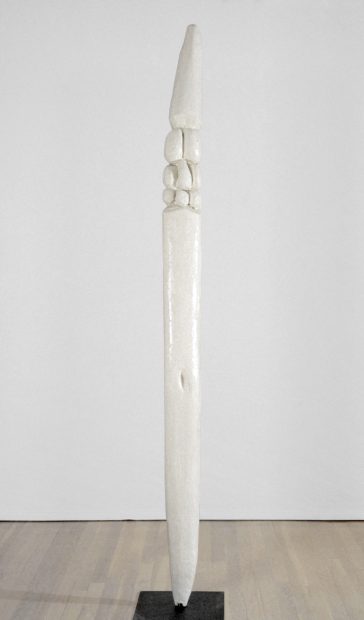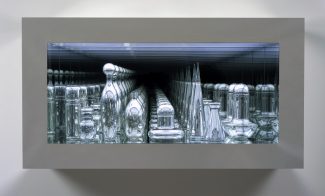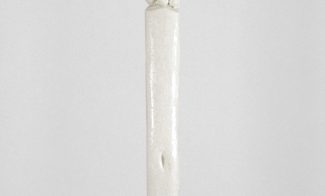I am captured when a contemporary artist takes the particular, their own experience, and creates something that has a universal resonance. A good example is Louise Bourgeois, an iconic figure and an inspiration cited by many women artists. She has often said her work is personal, a vehicle for expressing and grappling with the psychological struggles of her life. Her mother contracted the Spanish flu in 1919, never fully recovered, and died when Bourgeois was 20. This experience when Bourgeois was eight years old changed the artist’s life and was amplified by secondary and other, later losses.
I have seen many of Bourgeois’s monumental artworks – her “spiders” and elaborate installations come to mind. In contrast, Untitled stands quietly in the gallery. There is something self-contained and almost luminescent about its presence. At least one visitor described it as “cold.” My first impression is of something tall, slender, almost fragile, as it stands on its tapered end. There is a rigid tension to the piece, which contrasts with the curves – there are no straight lines here. The rigid, elongated form is interrupted by round spherical shapes and a dimple, a kind of belly button, below the mid-point. The smooth, white surface of the sculpture evokes in me a tactile sensation, a wish to touch it, to feel how the piece was carved.
Louise Bourgeois created this sculpture, one of her many Personnages, in her mid-30s while living in a New York City apartment with her husband and sons. She describes feeling bereft, missing the friends and family she had left behind in France. Her way of dealing with this absence was to begin carving these sculptures out of wood, often keeping them near to her in her apartment. The artist’s son has said that she would carve pieces of balsa the way another woman might knit, often going to the roof of their apartment to work.
Who is the person this sculpture portrays? Typical of the artist, there are both elongated masculine and spherical feminine forms here. Was Bourgeois feeling the unmoored, often physical sensations that come with loss, seeking to restore what she had lost through the visceral sensations of close repetitive work? We may never decode her visual language, but we can recognize these patterns in her work. The artist has spoken about these sculptures as referring to people, and as autobiographical, capturing aspects of her own experience – feelings of tension, of fragility, of working hard to maintain balance. Loss evokes these responses in all of us.
Carol Jensen has given tours at the ICA. Engaging with visitors and art has been a rewarding addition to her other creative endeavors in art-making and as a psychotherapist and teacher/mentor.
Friday Art Notes are personal reflections on works of art shown or in the permanent collection of the ICA, written by ICA staff, volunteers, and supporters. Read more


